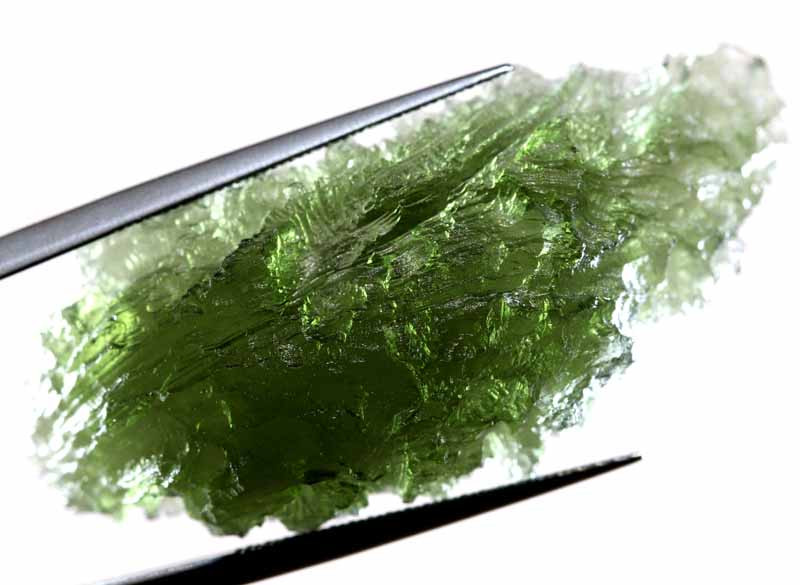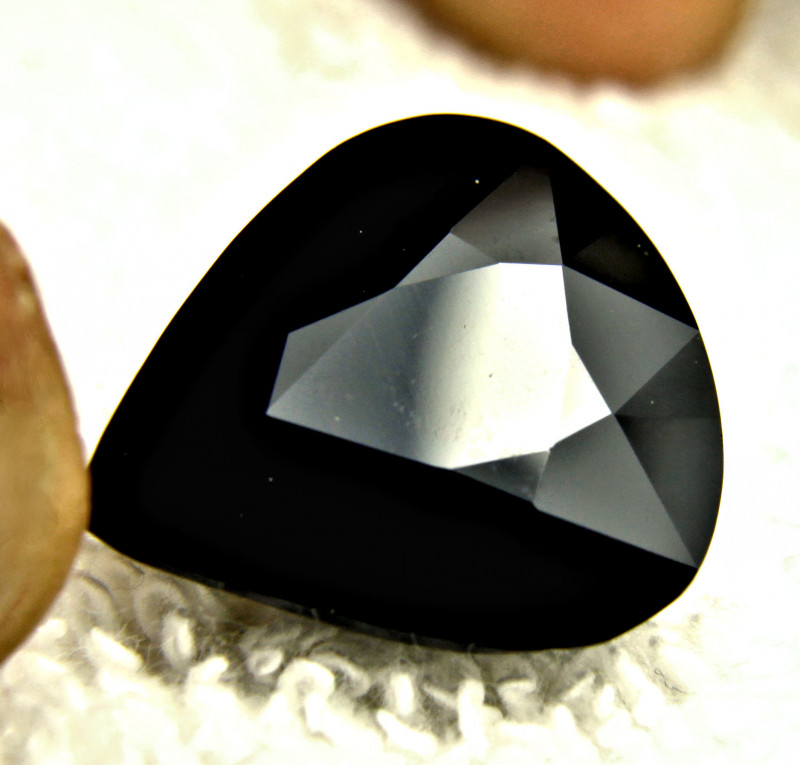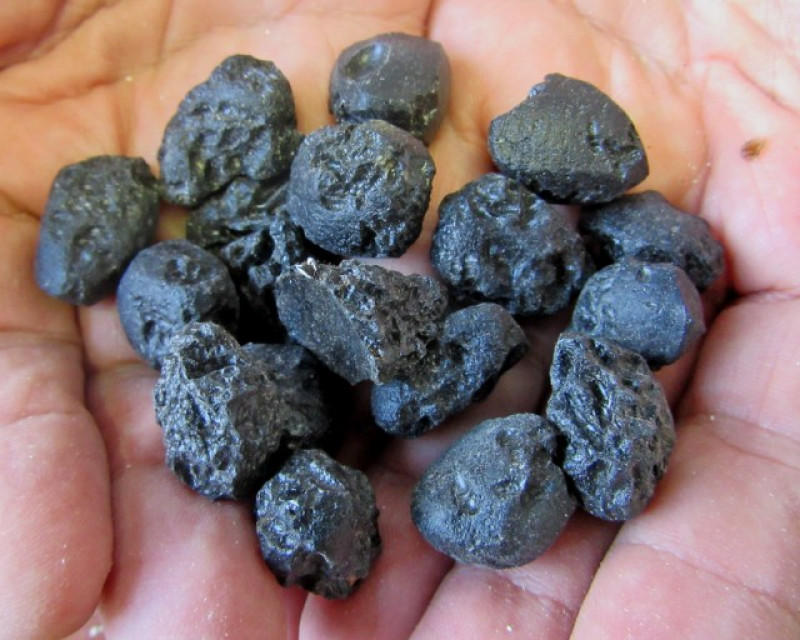
Tektite Gemstone: Properties, Meanings, Value & More
 Tektite is a unique and beautiful natural glass believed to have cosmic origins! Tektite gemstones resemble shiny, glass-like pebbles and are typically black but can also appear dark brown, gray, or green.
Tektite is a unique and beautiful natural glass believed to have cosmic origins! Tektite gemstones resemble shiny, glass-like pebbles and are typically black but can also appear dark brown, gray, or green.
Are tektites rare? Tektite can be found in a handful of places around the world, making it fairly rare. Little is still known about these pebble-like crystals, but their scarcity and mystery only add to tektite’s charm!
As your trusted source for all-things-gems, we’re excited to fill you in on all there is to know about this mystifying gem! Keep reading to get familiar with tektites’ meanings, properties, uses, value, and more.

About Tektite Stone
Much of tektite’s background is tied to meteorites, but is tektite a meteorite? Not exactly — it’s a semi-precious gemstone said to be the result of meteorite strikes on the earth and a few other origin theories, but more on that in a bit. Tektite’s name is rooted in the Greek word tektos, meaning “molten,” referencing the meteorite’s heat.
Is tektite lucky? You bet!
In numerology, tektite is associated with numbers one and nine.
While not classified as an official zodiac or star stone, this stellar gem’s connection to the cosmos allows it to resonate with every astrological sign! Tektite can amplify your strengths and weaknesses, no matter your zodiac sign.
Next, let’s touch on how to identify tektite!
Tektite Specifications & Characteristics
Tektites are irregular, intricately shaped glassy or crystalline nodules in varying blacks, grays, browns, or greens. A crystal system does not apply because tektite is an amorphous (non-crystalline) mineraloid.
You can easily confuse tektite’s physical appearance for obsidian. However, tektite and obsidian have entirely different chemical compositions! You can differentiate them through heating — obsidian bubbles (because of its water content) while tektite doesn’t (because it lacks water).
Here’s an overview of tektite’s mineral properties:
Formula: Variable; Silica (75%) + Al, Fe, Ca, Na, K, Mg, Ti, Mn
Mineral Family: Mineraloid / Meteorite
Composition: Glass
Mohs hardness: 5-6.5
Color: Black, green, yellowish-green, greenish-brown, brown, colorless
Crystal structure: Amorphous
Luster: Vitreous to dull
Transparency: Transparent to opaque
Refractive index: 1.46-1.54
Density: 2.21-3.40
Cleavage: None
Fracture: Conchoidal
Pleochroism: None
On another note, tektite’s composition can change depending on its locality. With that said, let’s explore some of tektite’s varieties!
Types of Tektite Crystals
Today, tektites’ source has been narrowed down to four well-defined strewn fields (or areas of meteorite impact) of different geological ages:
Microtektites — microscopic tektites less than a millimeter in diameter found in ocean sediments and polar ice.
Muong-Nong (or layered) tektites — named for where they were found (Muong Nong in Laos, Vietnam) and range from centimeter- to decimetre-size. This is the only one of the tektite groups occurring on land.
Splash-form tektites — “splash-form,” meaning they formed by melt splashed by impacts; typically shaped like spheres, ellipsoids, teardrops, disks, or dumbbells.
Ablated tektites — formed as solid splash forms reenter the atmosphere at high velocities, becoming partially remelted.
 Image: Moldavite tektite variety
Image: Moldavite tektite variety
Tektite Varieties
Among the main categories are different tektite variations, many of which are named after their locale. While some varieties are more common than others, they all relate but vary in composition.
Popular Varieties:
Australite
Australite is a dark, often black tektite variety from the Australasian strewn field (Southeast Asia impact crater) and is believed to be 0.77–0.78 million years old.
Bediasite
Bediasite, another black variety, is from the North American strewn field (Chesapeake Bay impact crater) in Texas, USA.
Darwin Glass
Darwin glass (or darwinite) is a light to dark green, white, or black variety from Tasmania, Australia.
Georgiaite
Georgiaite is a yellowish, green, sometimes blue tektite from the North American strewn field (Chesapeake Bay impact crater) in Georgia, USA.
Tektite moldavite is a dark to light, blue to green tektite variety from the Nördlinger Ries Crater in southern Germany. It’s believed to be over 15-million years old.
Philippinite
As implied in the name, philippine is a dark variety from the Philippines. Philippinite is believed to be about 710,000 years old.
Zhamanshinite
This is the name given to tektites from the Zhamanshin meteor crater about a million years ago.
Lesser-known Varieties:
Bikolite
Bikolite is a variety from the Bikol area of the Philippines.
Billonite
Billonite is a tektite material from Billiton Island (between Sumatra and Borneo).
Chinite
Chinite is a black tektite also from the Australasian strewn field. It was found in China, hence its name.
Indochinite
Indochinite is a dark, mostly black variety predominantly found in South-East Asia and Australia, and possibly in Canada. The crater of this strewn field is believed to be in Southern Laos.
Irghizite
Irghizite is a variety from the Zhamanshin meteor crater in Kazakhstan.
Ivorite
Ivorite is a black variety from the Ivory Coast strewn field (Lake Bosumtwi Crater, Ghana). It’s found in the Côte d'Ivoire (Ivory Coast).
Uruguaite
A more recent discovery, uruguaite, is a black variety from a new strewn field discovered in 2016.
Phew. That’s a lot of tektites!
Let’s switch gears and see how this otherworldly gem has appeared throughout history!

Tektite Meaning & History
For centuries, tektite’s meaning and origination have been surrounded by mystery in the world of geology.
The first recorded mention of tektite comes from China during the T’ang dynasty in 900 B.C. It comes from a book by Liu Sun (a prolific Chinese author) with a title loosely translated to “Notes on the Wonders Beyond the Nanling Mountains in Kwangtung.”
Sun talks about collecting lei-gong-mo, or inkstones of the Thundergods, after rainstorms. He describes these objects as lustrous, black stones that rang when hit.
After this, tektite seemed to fly under the radar till the late 19th and early 20th centuries. Around this time, Parisian researcher Alfred Lacroix discovered a large tektite deposit in Indonesia, then the Ivory Coast not long after. These discoveries, along with Lacroix’s published research, sparked further scientific interest in tektite worldwide.
Scientists spent the first half of the 20th century locating and identifying additional tektites and their localities around the globe. As they discovered more deposits, many hypotheses emerged about the origin of tektites’ unique chemical and physical properties.
In the 1950s and 60s, tektite research made its way to the forefront because of its alleged lunar (moon) origin. Although this theory was eventually debunked, the data collected laid the foundation for much of the tektite research happening today.
Moving on, what is a tektite gemstone used for in terms of healing?

Tektite Healing Properties
All crystals have metaphysical properties that make them healing stones. Tektite is believed to be a mighty healing tool because of its otherworldly connections. Its cosmic energy provides a multitude of physical, emotional, and spiritual healing powers.
Let’s see how you can harness tektite’s energy to restore your mind, body, and spirit!
Physical Healing
Tektite can be a superstar physical healer. It can accelerate healing from injury or illness, improve circulatory problems, and aid with fertility.
Hate that pre-workout you forcefully chug before heading to the gym? Wearing a tektite can make you feel physically stronger and help with a quick recovery. Hello, new personal record!
Emotional Healing
Similar to the physical benefits, wearing a tektite can strengthen you mentally. It may broaden your vision and hone your concentration to see the bigger picture.
As a vessel of telepathic exploration, it can enhance your psychic abilities and stimulate astral travel or lucid dreaming.
Need a desktop talisman to get your productive juices flowing? Tektite can help promote knowledge, improve memory, and inspire motivation. Its inspirational energy also resonates with creatives.
Chakra Healing
Chakra stones hold special energies tuned to one or more of the energy points (chakras) along the body's center. Tektite’s intergalactic vibrations, however, can be placed on any one of them to enhance that chakra’s optimal traits.
For instance, you can place tektite on the crown (surface of head) to seek clarity and expansion of the mind. If you wish to improve your clairvoyant vision, you can place tektite on your third eye (forehead, between the eyes).

Tektite Gemstone Properties
The value of tektites is dependent on many standard factors of other gems: color, cut, clarity, and size — with some minor variations.
Color
Most tektites are opaque with dark variations of colors. Translucent and lighter gems tend to fetch higher prices for their obscurity. However, dark colors are still sought after.
Cut
Tektite’s moderate hardness can make cutting tricky. Skilled lapidaries can facet tektite into popular shapes like cushions and fancy cuts — as well as unfaceted shapes like cabochons or decorative carvings.
Raw tektite is also popular for jewelry and display. The value of raw specimens varies on their shape, size, and visual appeal.
Clarity
It’s pretty common for tektite gems to display inclusions of rounded or bullet-shaped bubbles and swirly lines/ridges. These inclusions don’t seem to impact price and are instead a question of preference.
Carat Weight & Size
You can measure tektite in carats, grams, or millimeters interchangeably.
Most specimens are quite small (1-5 grams). Larger specimens of tektite are rare.
Treatments
While tektite doesn't typically undergo treatments, sellers can enhance the glossy finish through pre-oiling (polishing with mineral or cedar oil). This treatment doesn’t impact tektite’s value or purported healing properties.
So how are tektites formed anyway?

Tektite Origins & Sources
There is still much to be discovered about tektites! As for its origins, a few theories have been discussed, ranging from atomic explosions to moon rocks. However, most researchers believe meteorites hold the answer.
Is tektite meteorite? Currently, the leading theory is that tektite forms because of meteorites!
According to scientists, tektite is a fused glass caused by a meteorite impacting Earth. This crash brings tremendous heat and pressure. Material from the earth (rock, sediment, etc.) melted on impact, blasted into the air, and fell back to Earth — cooling into the glassy, pebble-like nodules we now know as tektites.
Mining Locations
Where are tektites found? In several pockets throughout the world! You can find tektites in:
Australia
China
Czech Republic (moldavite)
Northwest Africa
Thailand
United States
Vietnam
Intrigued by this terrestrial debris? Let’s see how these gems fare in price!

Tektite Price & Value
Are tektites expensive? Prices can vary depending on where you buy them. Places where tektite is found abundantly will fetch lower prices, with value increasing as you venture further away from the source.
Here’s a brief snapshot of the approximate prices (per gram) that most common tektite varieties go for:
Australites — Typical grades: $1 to $10 per gram; Higher grades: $30 to $50 per gram and extending upwards of $1000
Bornites — More elusive; about $2 per gram
Billitonites — About $1.5 to $2 per gram
Darwin Glass — $1 to $1.5 per gram; splash-forms and better shapes about $2 to $7 per gram
Georgiaites — About $100 a gram
Indochinites — Typical grades: $0.1 to $0.7 per gram; Higher grades: $1 per gram
Irghizites — About $2 per gram
Ivorites — About $100 to $300 per gram
Moldavites — Typical grades: $11 to $13 per gram; Higher grades: $16 to $22 per gram
Philippinites — Typical grades: $0.2 to $1.0 per gram; Higher grades: $3 to $5 per gram
Uruguaites — Over $100 per gram
Zhamanshinites — About $0.15 to $0.30 per gram
Now that you know how tektites fit your budget, here's the best way to ensure your gems maintain their beauty and metaphysical powers for years to come!
Tektite Care and Maintenance
Don’t be swayed by tektite’s moderate hardness; this crystal is still susceptible to scratches and accidental breakage, so proper care is essential.
To clean your tektite, simply use a soft brush, gentle soap, and warm water.
Avoid your tektite coming into contact with:
Harsh chemicals/acids
Steam cleaners
Ultrasonic cleaners
Brunt impacts
Extreme temperature changes
With respect to jewelry, your tektite rings should receive protective settings. You should only wear them occasionally. Other jewelry like pendants and earrings shouldn’t be a problem.
Store your tektite in a soft pouch or fabric-lined box away from harder gems.

Reach for the Stars with Tektite!
Tektite is so much more than molten glass! Its unique appearance is enough to take your gem collection to lunar heights. If that doesn’t convince you, tektite’s cosmic energy and ties to the skies will elevate your bliss and expand your mind with its extraterrestrial magic!
Ready to take off with tektite? Buy tektite gemstones today!
Search the Gemstone Encyclopedia
Related Auctions
Related Articles
Originally the Birthstones or gemstones were associated with a zodiac sign or the month of a individuals birth. Find out what your stone is and view the stones we have for sale
8th Feb 2021
There are dozens of quartz and chalcedony gems with various colors and patterns. Learn all about quartz properties and every type of quartz, from amethyst and agate to plasma and phantom quartz!
15th Oct 2020
Hackmanite is a pink to violet sodalite gem known for its unique color-change and luminescence. Learn why hackmanite is special, from its rare qualities to the types of hackmanite jewelry available.
28th Mar 2018
Latest Articles
Yugawaralite is a rare colorless, white, or pinkish zeolite crystal named for its discovery in Yugawara, Japan. Here we uncover the multifaceted history, properties, prices, and uses of yugawaralite.
24th Mar 2025
Simpsonite is a lesser-known mineral known on the gem market for its durability, yellow-orange color, and rarity. Discover all the properties, uses, prices, and history of simpsonite.
3rd Mar 2025
Kurnakovite is a colorless crystal related to inderite and rarely faceted but known among collectors. Explore the mineral traits, history, prices, and more in this kurnakovite guide.
17th Feb 2025
Article Categories
How To's is where you will find helpful articles from gem Rock Auctions on how to cut gemstones, select gemstones and buy gemstones.
9 Articles





